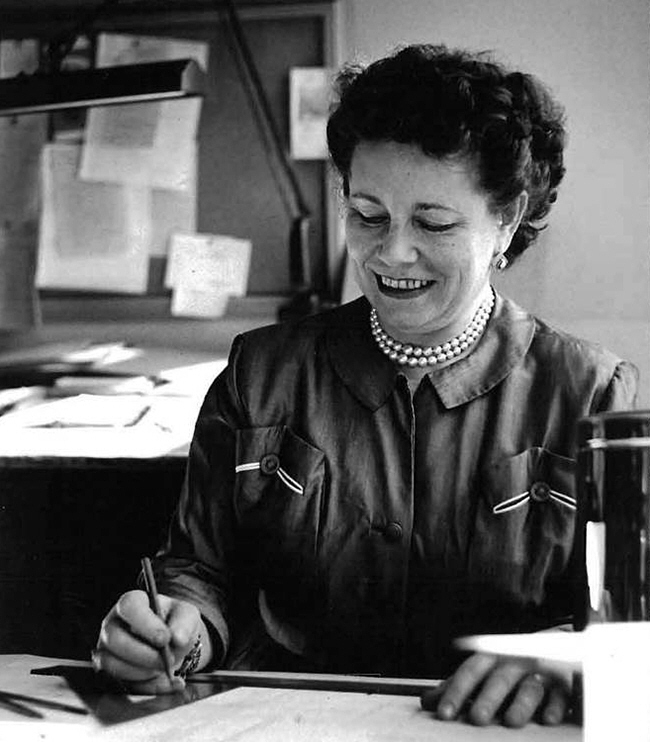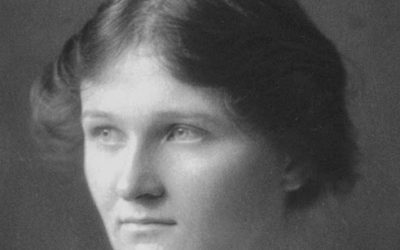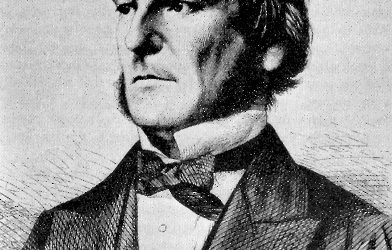Industrial design is a field that many of us don’t consider often, even though it affects how we live and work every day. From the chairs that keep us comfortable to the coffee mugs that keep us awake, the products we use are all the result of someone’s design ideas. That designer may be an architect or an upholsterer, an engineer or an artist, but no matter who does it the task of designing is a weighty one. It’s such a critical aspect of manufacturing, in fact, that many businessmen were once convinced that women weren’t up to it.
A review of the most influential American designers of the 20th century turns up a lot of male names: Raymond Loewy, Henry Dreyfuss and Norman Bel Geddes, to name just a few. Even products intended for use by women were often designed by a man. There were notable exceptions, of course: we’ve already seen the accomplished interior designer Maria Bergson, and we could also look to male-female partnerships such as the prolific Charles and Ray Eames. But the first American woman to make a name for herself as an industrial designer of all kinds of products was the Russian-born immigrant Belle Kogan.
Kogan was born as Bella Cohen in Ilyashevka, Russia in 1902, but when she was only six her father moved the family to Allentown, Pennsylvania. Her father was a jeweler, and Kogan herself developed a strong interest in art. It may have been this passion that led her high school art teacher to recommend that she enroll in a Mechanical Drawing class; on her first day Kogan realized that she was the only woman in the room, an experience that was to recur many times during her design career.
After graduating high school in 1920, Kogan hoped to earn a degree at the Pratt Institute in Brooklyn, supporting herself by teaching the same Mechanical Design class she had recently attended. Unfortunately, in the middle of her first semester she was pulled away by the needs of her family. She would spend nearly a decade helping to run her father’s jewelry store and raise her younger siblings. Even with these obligations, she was able to attend the Art Students League in New York and make some progress toward higher education.
In a curious twist of fate, Belle Kogan’s true career began in 1929, the year that witnessed Black Tuesday and the onset of the Great Depression. It was in the summer of 1929 that she was offered a job by a young manufacturing concern, the Quaker Silver Company of North Attleboro, Massachusetts. Quaker took a chance with Kogan; not only did they hire her, but they also paid to have her first attend design classes in Rhode Island and Germany. She credited these classes with teaching her that design was a serious discipline that “didn’t just happen”, and that knowledge in many fields was required for good product design: business management, mechanics, aesthetics and many others.
Kogan became one of Quaker’s top designers, and her efforts were rewarded with increased trust. By 1932, the company offered her a retainer that permitted her to leave their direct employment and set up shop as a freelance designer. Newly independent, Kogan struggled to develop her business with clients who dismissed her talent and, sometimes, didn’t even know who she really was. In 1939 she recounted in an interview her experience of receiving a letter addressed to a “Mr. Bell Kogan” from a large appliance company. Kogan traveled to their headquarters, where the company engineers realized for the first time that she was a woman and refused to work with her. She didn’t waste time on recriminations, but simply collected her consulting fee and left.
This was merely the most overt of many obstacles that stood in Kogan’s way. She often found that businessmen were resistant to her ideas, not just because many of them were new but also because of her gender and art-oriented background. Some clients assumed that her designs would focus on aesthetics and ignore mechanical considerations that, in their minds, she couldn’t possibly have understood. Others disregarded the line between personal and professional, suggesting dinner meetings or evening rendezvous, implying that their minds weren’t really on work.
Kogan, a true professional, rose above these distractions and continued to expand into new fields. Her designs were elegant, like her silver-plated vegetable dish for Reed and Barton; charming, like her duck-shaped electric alarm clock for Telechron and a set of glass piglets for Viking Glass; and stylish, like her series of Zippo lighters in 1938, or her Prismatique ceramics for Red Wing Pottery. She designed for men and women, children and adults, with materials ranging from wood to Melamine, and always kept in sight her goal of marrying practicality with aesthetic originality.
Belle Kogan was a pioneer in the realm of industrial design. She demonstrated that women had a place in design, and a voice, that merited attention. Practically the first woman in her field, she helped to found the Industrial Designers Institute and was one of only a handful of women to be recognized by the Industrial Designers Society of America for her achievements. But while she often stood alone, she knew that she was essentially representing female consumers all over the United States. As she succinctly put it:
“…Thirty million women—all potential customers—constituting practically the entire buying structure of the nation—comprise a force which cannot, or should not, be disregarded. The tastes of the American woman, her reaction to color and form, are of vital importance to the manufacturer.”
Next Post: Patsy Sherman, the 3M chemist who turned down an “ideal” career in homemaking.














